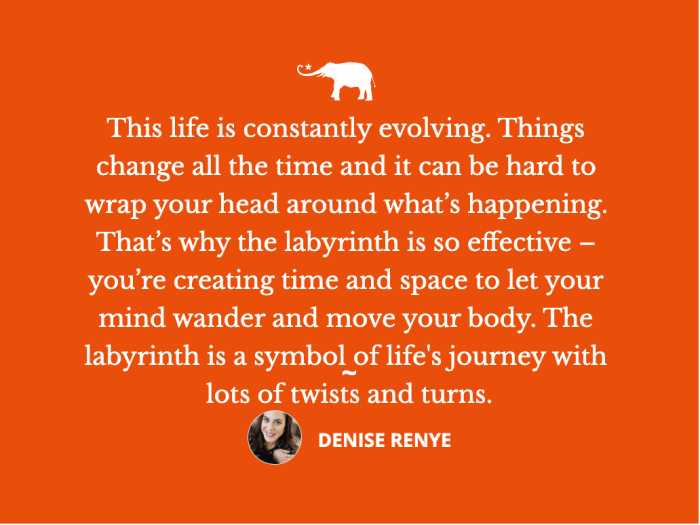By: Dr. Denise Renye
Labyrinths play an integral part in the work I do with patients, clients, and students. I recommend labyrinths as an integration tool because they can help connect the body, mind, and spirit. Integration could be around processing a psychedelic experience but it could also be for integrating any portion of the human experience, really.
Also, while labyrinths are associated with Christianity, they may or may not be affiliated with any religion or sect. In fact, prehistoric and preindustrial cultures also used labyrinths. They were often found in caves and were seen as a “quest for integration of the individual soul with a higher energy force, perceived as the self, eternal spirit, the earth, and the goddess all at once,” according to Wisdom Words PPF. They are vessels, sacred containers, that may help you deepen your practice of embodiment and ultimately integrate the body-mind.
This life is constantly evolving. Things change all the time and it can be hard to wrap your head around what’s happening. That’s why the labyrinth is so effective – you’re creating time and space to let your mind wander and move your body. The labyrinth is a symbol of life’s journey with lots of twists and turns. However, unlike a maze, the labyrinth has one way in (symbolizing birth) and one way out (symbolizing death). Also unlike a maze, you can walk off a labyrinth at any time. You can choose to stop your labyrinth journey and are never trapped.
Because the labyrinth is an active exercise, it’s a form of movement meditation and may be useful for folx who are healing from PTSD and find it difficult to sit still for meditation. While walking the labyrinth (or running, or jumping, or dancing, or wheeling. . .), much may arise. You may feel agitated or peaceful. Sad or joyful. There is no “right” way to use a labyrinth, and at the same time, it can be helpful to work with a labyrinth facilitator such as me.
I was first trained in the use of labyrinths when I was 19 years old. At my college, we created a canvas labyrinth that we unfurled to be used as a space holder for students and neighborhood folx to come and have respite from their everyday lives. They could bring their concerns and issues to the labyrinth. When they got to the center, they could choose to leave something in the middle (a tangible object or a mental burden they’ve been carrying), or not. Often, they left feeling different than they did when they arrived. That’s the power of a labyrinth journey.
I am also certified through Veriditas, an organization founded by Dr. Lauren Artress who started a resurgence of deep healing through the use of the labyrinth as a meditation tool. As a facilitator, I can address meditative walking in a variety of settings, with a variety of different populations. That means I can talk about the benefits of a labyrinth in business settings, spiritual settings, and secular settings. And because there are labyrinths all over the world, this sort of work can be done in a wide variety of settings and places.
As a trained labyrinth facilitator, I know how to hold the labyrinth space before, during, and after the walk. I’m equipped to guide people through any usual or unusual experiences and talk with them about it to fully integrate their experience. I use this tool, when appropriate, with individuals, couples, and groups. The labyrinth can be used as a tool to help integrate the psyche, soma, and spirit for a wide array of reasons. I have used it to help folx with grieving and to transition into a new phase of life. It can be used with couples as a way to help them learn how important it is to walk together in this time period of their lives as well as how they are different and similar to each other.
The labyrinth can be used in family therapy or coaching as a way to help family members see each other, witness each other, and learn a way to move in this world both together and separately. I have used it as a tool in executive coaching to help individuals and teams understand their business targets by giving them time to reflect and to provide spaciousness for their business launches and organizational changes.
The labyrinth is a tool that can be used universally for many different reasons. Go ahead and give it a try. And if you want more structure and support, reach out to me.
For more tips on living a whole person, fully integrated kind of life, subscribe to my newsletter.
Reference
Unknown. “Pre-Christian Origins of the Labyrinth.” Wisdom Words PPF. April 28, 2017. https://www.wisdomwordsppf.org/2017/04/28/pre-christian-origins-labyrinth/


 Share on bsky
Share on bsky





Read 0 comments and reply